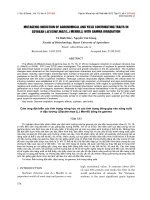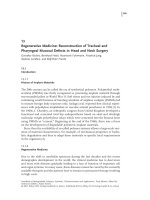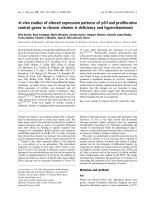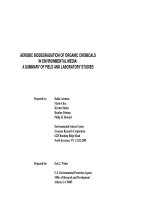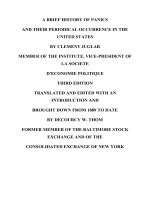Green synthesis of nanoparticles and their possible avenues in environmental application – A review
Bạn đang xem bản rút gọn của tài liệu. Xem và tải ngay bản đầy đủ của tài liệu tại đây (251.33 KB, 7 trang )
Int.J.Curr.Microbiol.App.Sci (2019) 8(10): 2644-2650
International Journal of Current Microbiology and Applied Sciences
ISSN: 2319-7706 Volume 8 Number 10 (2019)
Journal homepage:
Review Article
/>
Green Synthesis of Nanoparticles and their Possible Avenues in
Environmental Application – A Review
S. Saritha1 and V. Prabha2*
1
2
MMES Women’s Arts and Science College, Vellore, Tamil Nadu, India
Department of Biochemistry, DKM College for Women, Vellore, Tamil Nadu, India
*Corresponding author
ABSTRACT
Keywords
Nanoremediation,
Nanotechnology,
Green synthesis,
Photocatalysis,
Electro signaling
Article Info
Accepted:
15 September 2019
Available Online:
10 October 2019
Nanotechnology plays a crucial role in addressing the innovations and
solution to vast challenges in various fields. In recent years, green synthesis
has gained extensive attention based on its reliability and stability. The use
and development of nanomaterials using biogenic approach has several
advantaged on environment and defined as nanoremediation. This
beneficial technology can also be designed in order to decrease the risk of
environmental pollution. This review deals with the types of nanoparticles,
various routes involved in the synthesis of the nanomaterial. This mini
review highlights the employment of green synthesized nanomaterials in
gas sensors, electro signaling and photocatalysis.
Introduction
Nanotechnology has emerged during 1980’s
and has become the center of attraction in the
21st century for both public and scientific
community. Nanotechnology can be simply
defined as understanding and control of matter
at dimension between 1 and 100 nm that
results in succeeding novel and effective
applications (Murugan et al 2014). In other
words, engineering and exploring the
applications of nanomaterials with smaller
size(Whatmore 2006). These particles are
microscopic with minimum one dimension
less than 100 nm(Garg et al 2011).The
physical properties of nanoparticles differ
largely compared with bulk materials because
nanoparticle exhibit relatively large surface
area. Additionally, the particle at nanoscale
has length lesser than de Broglie wavelength
of the charge carrier or wavelength of light.
This interesting property of nanoparticle has
made them an efficient candidate in various
fields of science and technology. This modern
day technology plays a vital role in day to day
life of modern human being.
In this modern era, nanotechnology has
attained greater importance and its budding
applications has several beneficial impacts on
2644
Int.J.Curr.Microbiol.App.Sci (2019) 8(10): 2644-2650
the society in various fields such as
Environment, Engineering, Pharmaceutical,
Agriculture and so on. Among various general
applications, use of Titanium (Ti) and Zinc
(Zn) in bioremediation has highly attracted the
scientific community. The involvement of
nanotechnology in environmental sector
widely includes waste water treatment, soil
remediation, sensors and energy storages etc
(Wang and Dai 2013). On the other hand,
scheming the nanomaterial for environmental
issues should also bear safety towards the
ecosystem which greatly includes living
beings and the sources of life with potential
environmental benefits(Hutchison 2008). In
this mini review, we have discussed about the
types of platform of nanoparticles, general
approaches to synthesize nanoparticles by
biological means and its use in environmental
applications.
Numerous forms/platforms of nanoparticles
The various forms of nanoparticles includes
inorganic
nanoparticles,
polymeric
nanoparticles, solid lipid nanoparticles,
liposomes,
nanocrystals,
nanotubes,
dendrimers
etc
(Fig
1).
Inorganic
nanoparticles have greatly attained the
attention of the research community in the
field of biotechnology mainly due to the
exceptional
physical
property.
These
nanoparticle exhibit size dependent optical,
magnetic, electronic and property of
catalyzing the reaction (Ladj et al
2013).Polymeric nanoparticles are one such
nanoparticles highly employed in research.
The scattering of polymer and polymerization
of monomers are the crucial approaches
involved for the materialization of polymeric
nanoparticles (Prasad Rao and Kurt Geckeler
2011). In conserving the liberating
effectiveness of drug in 1990 solid lipid
nanoparticles were introduced and they played
a vital role in the field of drug delivery. They
act as carrier system to emulsion, liposomes
and polymeric nanoparticles (Abhilash 2010).
Liposomes are another form of nanoparticles
used in the field of drug delivery that consist
of one or more phospholipids bilayer that
carry the compound of interest to the site of
action. Liposomes are widely used in the field
of pharmaceuticals and food industries in
delivering the drug by acting as catalyst.
Encapsulation of unstable compounds are
done using the liposomes(Akbarzadeh et al
2013). Apart for these, quantum dots are
semiconductors with size lesser than 10 nm in
diameter. These quantum dots exhibit specific
size dependent electronic and optical
properties(Collier et al 1998). Most of the
quantum dots are arranged based on core and
shell material. The core consists of cadmium
selenium as core and zinc selenium as cap or
shell (Jovin 2003). These quantum dots are
widely used in biological research such as
fluorescence imaging and biomolecule
tracking.
Various
routes
nanoparticles
for
synthesis
of
Nanoparticles were synthesized by means of
three different methods i) Chemical method ii)
physical methods and iii) Biological method.
Synthesis of nanoparticles by chemical means
was considered to be quick and ancient
methods but later it was found to be toxic due
to the chemicals used during capping and
stabilizing. These nanoparticles were observed
to be toxic to ecosystem. On the other hand,
physical method of nanoparticle synthesis is
considered to one of the expensive methods
involving complex means in fabricating the
nanoparticles. Due to toxic effect, nanoparticle
synthesized using physical and chemical
methods are not employed in the field of drugs
and therapeutics. To overcome these
disadvantages,
green
synthesis
of
nanoparticles was introduced which results in
non-toxic and eco-friendly compounds. It was
observed that, the biological materials bear the
tendency to reduce the metals to metal ions
2645
Int.J.Curr.Microbiol.App.Sci (2019) 8(10): 2644-2650
easily with less cost and low toxicity when
compared with physical and chemical
methods. For synthesizing metal or metal
oxide nanoparticle, plant and microbial
diversity has been highly exploited due to the
presence of secondary metabolites such as
flavones, terpenoids, carboxylic acids,
phenols, aldehydes and ketones. These
secondary metabolites play an essential in
reducing metals into metal ions (Doble and
Kruthiventi 2007).
low cost. Various plants such as copper leaf,
china rose, green tea, aloe vera, crown flower,
alfalfa, mustard were highly studied for its
efficacy in synthesizing nanoparticles in vivo
by reducing metal salts to metal ions. The
nanoparticles synthesized by means of green
synthesis were found to be stable. Ag
nanoparticles fabricated using tea leaf extract
were found to be very stable when introduced
into the aquatic environment(Sun et al 2014).
Environmental
nanotechnology
Green synthesis of nanoparticles
Due to increased cost, high toxicity, higher
radiation over environment and human beings,
physical
and
chemical
methods
of
nanoparticle fabrication is being less used. On
the other hand, green synthesis of
nanoparticles was found to be a single step
process that utilize very less energy for
initiating the reaction. This method of
nanoparticle synthesis were considered to be
an effective, non-toxic, bio friendly method
(Dahoumane et al 2016; El-Rafie et al 2013;
Husen and Siddiqi 2014;Khan et al 2015).
Among plants and other biological
components, bacteria play a key role in bioreduction of metal salts into metal ions.
Generally, bacterial species are highly
recommended in biotechnological applications
such as genetic engineering, bioremediation,
bioleaching etc(Gericke and Pinches 2006).
Bacterial means of synthesis is found to be
easier since the manipulation, growth and
cultivation process is found to be simpler
(Thakkar et al 2010). Likewise, fungi have
many advantages over the other due to the
existence of all indispensable metabolites on
the surface of the cell wall (Narayanan and
Sakthivel 2011). Comparatively, fungal
isolates were observed to synthesis enormous
quantity of nanoparticles when likened with
that of bacteria (Mohanpuria et al 2008).
Plants have higher potential in synthesizing
nanoparticles efficiently and effectively with
application
of
Environmental pollution and protection
remains as an important issue to be addressed
at the earliest for maintaining the healthy
ecosystem. Trace amount of pest, oil, dye,
heavy metals with high chloride concentration
in water purifiers were reported by (Jadhav et
al 2013). In order to remediate the pollution,
various approaches has been employed which
broadly includes, bioremediation, phytoremediation, rhizoremediation, nanotechnology etc. Recent studies utilize the efficiency
of nanoparticles in remediating the polluted
sites, which has now been termed as nano
remediation. Nano remediation has become an
effective method for remediating the polluted
landfills using the substantial role in sensing,
observing and remediating (Rajan 2011).
These nano remediation remains as an
alternate for the current day expensive
treatments such as thermal treatment, chemical
oxidation and surfactant co solvents flushing
etc (Löffler and Edwards 2006).
Nanotechnology has been exploited in
constructing low cost but highly sensitized
detecting system for checking the quality of
air and water with high stability and
selectivity. These nanoparticles based
detection system has the potential to detect
toxins, heavy metals and other gaseous
pollutants surrounded in the environment
(Hristozov and Ertel 2009). These Nano
2646
Int.J.Curr.Microbiol.App.Sci (2019) 8(10): 2644-2650
sensors in an advanced level are being used to
detect the presence of microbes in food and
other edible substances (Butnar and Llop).
(Balavigneswaran et al 2014).
Photocatalysis and catalytic efficacy of
nanoparticles
Sensing and monitoring system
Gas sensors
Gas sensors or chemical sensors play a crucial
role in observing environmental pollution in
air, water and soil (Zhang et al 2016). It is also
employed in detecting the other environmental
pollutions caused by organic dyes in food and
leather industries. Specific and selective
sensors are used for detecting the leakage of
the toxic compound form the industries(Asad
and Sheikhi 2016). Recently, sensors made up
of nanoparticles such as SnO2, WO3, ZnO are
recommended for gas sensors (Comini 2006
andKumar et al 2015). Due to the specific
properties such as sensitivity, stability and low
cost ZnO nanoparticles are used in
determining the toxic compounds present in
the environment (Han et al 2016 and Ozgur et
al 2005).
Electro chemical signaling
Apart from heavy metal detection, single
walled nanotubes were also used to develop a
paper based sensor for detecting microcystin –
LR with detection limit of 0.6 ppb (Wang et al
2009). Correspondingly, electrochemical
immune sensor a single walled carbon
nanohorns functionalized using analyte with
detection limit of 0.03 µg/ml were designed
(Zhang et al 2010). Similarly encapsulated Au
nanoparticles were used for detecting the
presence of pathogenic strain such as E. coli,
Cryptosporidium sp and Giardia sp etc.
Toxins such as shiga-like toxin 1, cholera
toxin, staphylococcal enterotoxin B were
determined. Silver nanoparticles synthesized
using Anacardium occidentale has been
reported to be an effective probe in sensing
chromium ions present in the tap water
Nanoparticle containing higher surface area
are referred to possess higher catalytic
activity. Several reactions such as reduction of
nickel oxide to nickel (metal) are carried out
by nanoparticles. Titanium dioxide has
attracted the interest of the research
community due to its uniqueness in
photoreducing inorganic contaminants and
inactivating microorganisms, and enhancing
the photodegradation of numerous organic
pollutants (Chong et al 2010; Kurniawan and
Sillanpaa 2011). Since titanium exhibits less
toxicity, high photoconductivity and stability
it is been highly recommended for
photodegradation study (Choi et al 2014).
Development of photocatalytic process of
non-metal doped TiO2 has exhibited enormous
ability in treating water and considered to be
more ecofriendly approach compared with the
metal doped process in which the later process
is vulnerable to corrosion and other metal
problems. Apart from being an efficient
candidate in photocatalysis, nanoparticles
remain as a better catalyzer in enhancing the
rate of reactions. Green synthesized Ag
nanoparticles were reported in the reduction of
Methylene blue by NaBH4 and Reduction of
benzyl chloride (Suvith and Philip 2014 and
Jebakumar Immanuel Edison and Sethuraman
2013).
Due to increasing population and urbanization
the environment has been damaged to a
greater extent and an immediate and
permanent action is needed. The advent of
nanoremediation, using smarter technologies
remains as a boon for the environment. Ample
possibilities remain in the exploitation of
green synthesis tactics based on biogenic
approach. The nanobased technologies
remains eco-friendly, cost effective and less
2647
Int.J.Curr.Microbiol.App.Sci (2019) 8(10): 2644-2650
time consuming. The results obtained from the
sensors activated by means of nano materials
are reliable. This promising and innovative
technology helps us to understand the uses of
nanoparticles in both basic and field
demonstrations.
Fig.1Various forms of nanoparticles
Organic
Nanoparticles
(eg. Dendrimers,
Liposomes,
Micelles))
Various forms
of nanoparticles
Inorganic
nanoparticles
(eg. Metal based,
Metal oxides
based)
Carbon based
(eg. Carbon
nanofibers, Carbon
black, Graphene)
References
Abhilash M (2010) Potential applications of
Nanoparticles. Int J Pharma Bio Sci 1:
Akbarzadeh A, Sadabady RR-, Davaran S,
(2013)
Liposome:
classification,
preparation,
and
Applications.
Nanoscale Res Lett, 8:102.
Asad M, Sheikhi MH (2016) Highly sensitive
wireless H2S gas sensors at room
temperature based on CuO-SWCNT
hybrid nanomaterials, Sensor. Actuat
B—Chem 231:474_483.
Balavigneswaran CK, Kumar TSJ, Packiaraj
RM, Prakash S (2014) ―Rapid
detection of Cr(VI) by AgNPs probe
produced by Anacardium occidentale
fresh leaf extracts,.‖ Appl Nanosci
4:367–378,
Butnar I, Llop M Composition of greenhouse
gas emissions in Spain: an input-output
analysis,. Ecol Econ 61:388-395.
Choi H, Zakersalehi A, Al-Abed S (2014)
nanostructured titanium oxide filmand membranebased photocatalysis for
water treatment. In: Savage ASSD (ed)
Nanotechnology applications for clean
water, 2nd edn. William Andrew
Publishing, Oxford,. pp 123–132.
Chong M, Chow C, Saint C (2010) Recent
developments in photocatalytic water
treatment technology: a review. Water
Res 44:2997–3027.
Collier C, Vossmeyer T, Heath J (1998)
Nanocrystal superlattices. Ann Rev
Phys Chem 49:371-404.
Comini E (2006) Metal oxide nano-crystals
for gas sensing. Anal Chim Acta
568:28-40.
Dahoumane S, Yéprémian C, Djédiat C (2016)
2648
Int.J.Curr.Microbiol.App.Sci (2019) 8(10): 2644-2650
Improvement of kinetics, yield, and
colloidal stability of biogenic gold
nanoparticles using living cells of
Euglena
gracilis
microalga.
J
Nanoparticle
Res
https ://doi.
org/10.1007/s1105 1-016-3378-1.
Doble M, Kruthiventi A (2007) Green
chemistry and engineering. Cambridge
Acad Press
El-Rafie H, El-Rafie M, Zahran M (2013)
Green synthesis of silver nanoparticles
using polysaccharides extracted from
marine macro algae. Carbohydr Polym
96:403–10..
Garg A, Sharad V, Pramod Kumar S, Kumar
N (2011) Formulation, characterization
and application on nanoparticle: a
review. Der Pharm Sin 2:17-26.
Gericke M, Pinches A (2006) Microbial
production of gold nanoparticles. Gold
Bull 39:22–8.
Han, Liu B, Xing X, (2016) A high response
butanol gas sensor based on ZnO
hollow spheres. Sens Actuat B—Chem
237:423–430
Hristozov D, Ertel J (2009) Nanotechnology
and sustainability: benefits and risks of
nanotechnology for environmental
sustainability,. Forum der Forsch
22:161-168.
Husen A, Siddiqi K (2014) Plants and
microbes
assisted
selenium
nanoparticles:characterization
and
application.. J Nanobiotechnol 12:28
Hutchison JE (2008) Greener nanoscience: a
proactive approach to advancing
applications and reducing implications
of nanotechnology,. ACS Nano
2:395_402.
Jadhav SD, Jadhav MS, Jawale RW (2013)
Study of chloride and nitrate
concentration of MulaMutha River in
Pune city (Maharashtra). Int J Chem
Life Sci 2:1140–1142.
Jebakumar Immanuel Edison TN, Sethuraman
MG (2013) ―Electrocatalytic reduction
of benzyl chloride by green
synthesized silver nanoparticles using
pod extract of Acacia nilotica,.‖ ACS
Sustain Chem Eng 1:1326–1332
Jovin T (2003) Quantum dots finally come of
age. Nat Biotechnol 21:32–33
Khan M, Al-Marri A, Khan M (2015) Green
approach for the effective reduction of
graphene oxide using Salvadora
persica L. root (Miswak) extract.
Nanoscale Res Lett 10:1–9.
Kumar O, Al-Dossary G, Kumar A, Umar
(2015) Zinc oxide nanostructures for
NO2 gas-sensor applications: a
review,. Nano-Micro Lett 7:97-120.
Kurniawan
T,
Sillanpää
M
(2011)
Nanoadsorbents for remediation of
aquatic environment: local and
practical solutions for global water
pollution problems. Crit Rev Env Sci
Technol 42:1233–1295
Ladj R, Bitar A, Eissa M (2013) Individual
inorganic nanoparticles: preparation,
functionalization
and
in
vitro
biomedical diagnostic applications. J
Mater Chem B, 1:1381 1396.
Löffler FE, Edwards EA (2006) Harnessing
microbial activities for environmental
cleanup. Curr Opin Biotechnol,
17:274–284.
Mohanpuria P, Rana N, Yadav S (2008)
Biosynthesis
of
nanoparticles:
technological concepts and future
applications. J Nanoparticle Res
10:507–17
Murugan A, Kumara K, Shanmugasundaram
(2014)
Biosynthesis
and
characterization of silver nanoparticles
using the aqueous extract of vitex
negundo. linn. World J Pharm pharm
Sci 3:1385 1393.
Narayanan K, Sakthivel N (2011) Synthesis
and characterization of nanogold
composite using Cylindrocladium
floridanum and its heterogeneous
catalysis in the degradation of 4-
2649
Int.J.Curr.Microbiol.App.Sci (2019) 8(10): 2644-2650
nitrophenol. J Hazard Mater 189:519–
25.
Ozgur YI, Alivov C, Liu A (2005) A
comprehensive review of ZnO
materials and devices,. J Appl Phys
98:1-103.
Prasad Rao J, Kurt Geckeler E (2011) Polymer
nanoparticles: Preparation techniques
and size-control parameters. Prog
Polym Sci 36:887-913.
Rajan S (2011) Nanotechnology in
groundwater remediation. Int J Env Sci
Dev 2:182–187.
Sun Q, Cai X, Li J (2014) Green synthesis of
silver nanoparticles using tea leaf
extract and evaluation of their stability
and antibacterial activity. Colloids Surf
A Physicochem Eng Asp 444:226–31.
Suvith VS, Philip D (2014) ―Catalytic
degradation of methylene blue using
biosynthesized gold and silver
nanoparticles,.‖ Spectrochim Acta Part
A Mol Biomol Spectrosc 118:526–532
Thakkar K, Mhatre S, Parikh R (2010)
Biological synthesis of metallic
nanoparticles. Nanomed Nanotechnol
Biol Med 6:257–62
Wang HL, Dai HJ (2013) Strongly coupled
inorganic-nano-carbon
hybrid
materials for energy storage,. Chem
Soc Rev 42:3088_3113.
Wang W, Chen DH, Xu BS (2009) Simple,
rapid, sensitive, and versatile SWNTpaper sensor for environmental toxin
detection competitive with ELISA.
Nano Lett 9:4147-4152.
Whatmore R (2006) Nanotechnology what is
it? Should we be worried? Occup Med
56:295-299.
Zhang J, Liu XH, Neri G, Pinna N (2016)
Nanostructured materials for room
temperature gas sensors. Adv Mater
28:795-831.
Zhang X, Jia XJ, Lv YL (2010) Fluorescent
quantum dotlabeled aptamer bioprobes
specifically targeting mouse liver
cancer cells,. Talanta 81:505_509.
How to cite this article:
Saritha, S. and Prabha, V. 2019. Green Synthesis of Nanoparticles and their Possible Avenues
in Environmental Application – A Review. Int.J.Curr.Microbiol.App.Sci. 8(10): 2644-2650.
doi: />
2650
